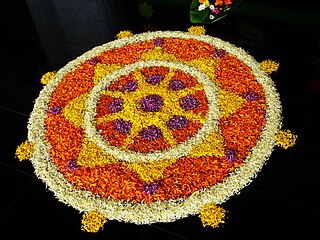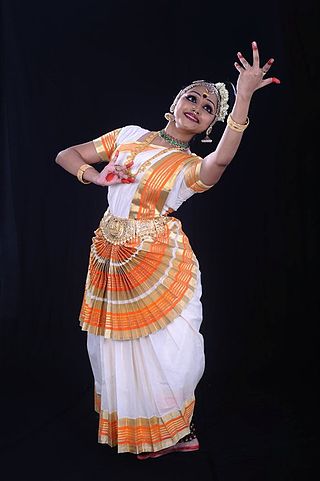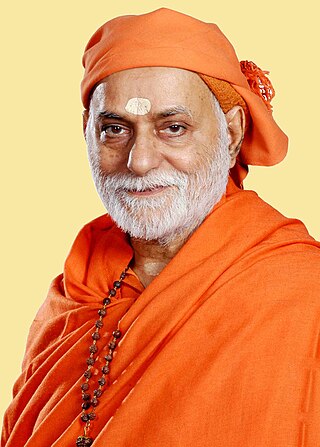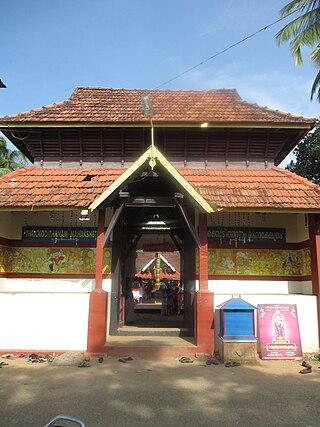
Kathakali is a traditional form of classical Indian dance, and one of the most complex forms of Indian theatre. It is a "story play" genre of art, but one distinguished by the elaborately colourful make-up and costumes of the traditional male actor-dancers. It is native to the Malayalam-language southwestern region of Kerala and is almost entirely practiced by Malayali people.

Onam is an annual harvest and cultural festival related to Hinduism that is celebrated mostly by the people of Kerala. A major annual event for Keralites, it is the official festival of the state and includes a spectrum of cultural events.

Kathak is one of the nine major forms of Indian classical dance. Its origin is attributed to the traveling bards in ancient northern India known as Kathakar ("storyteller"), who communicated stories from the Hindu epics through dance, songs and music. Its name derives from the Sanskrit word katha which means "story", and kathakar which means "the one who tells a story", or "to do with stories".
South Indian culture refers to the cultural region typically covering the South Indian states of Tamil Nadu, Karnataka, Kerala, Andhra Pradesh, and Telangana. The idea of South India is closely linked to the Dravidian ethnic and linguistic identity and therefore it can also refer to groups in central India such as the Gondi and the Kui. Similar to India it is difficult to define a common essence of South Indian culture. That being some common threads include the eternal universe through the celebration of the beauty of the body and femininity. It is exemplified through its dance, clothing, and sculptures.

The mundu is a garment worn around the waist in the Indian states of Kerala, Tamil Nadu, the Lakshadweep archipelago, and the Indian Ocean island nation of Maldives. It is closely related to sarongs like dhotis and lungis. It is normally woven in cotton and coloured white or cream. The colour is dependent on whether the cotton is bleached or unbleached. A khadaṟ muṇṭŭ is made using handlooms. When unbleached, the mundu is called nēriyatu. In modern times, two types of mundu are prevalent—the single and the double. A single mundu is wrapped only once around the waist, while the double one is folded in half before wearing. A mundu is usually starched before use.

Mohiniyattam is an Indian classical dance form originating from the state of Kerala. The dance gets its name from Mohini – the female enchantress avatar of the Hindu deity Vishnu, who helps the devas prevail over the asuras using her feminine charm.

The Malayali people are a Dravidian ethnolinguistic group originating from the present-day state of Kerala & Union Territory of Lakshadweep in India, occupying its southwestern Malabar coast. They form the majority of the population in Kerala and Lakshadweep. They are predominantly native speakers of the Malayalam language, one of the six classical languages of India. The state of Kerala was created in 1956 through the States Reorganisation Act. Prior to that, since the 1800s existed the Kingdom of Cochin, the Kingdom of Travancore, Malabar District, and South Canara of the British India. The Malabar District was annexed by the British through the Third Mysore War (1790–92) from Tipu Sultan. Before that, the Malabar District was under various kingdoms including the Zamorins of Calicut, Kingdom of Tanur, Arakkal kingdom, Kolathunadu, Valluvanad, and Palakkad Rajas.

Kerala Natanam is a new style of dance that is now recognised as a distinct art form evolved from Kathakali, a form of Indian dance-drama. The Indian dancer Guru Gopinath a well-trained Kathakali artist and his wife Thankamani Gopinath who was the first student of Mohiniyattam in Kerala Kalamandalam developed a unique structure for teaching and performing classical dance forms of India whose origins are from Kathakali. Solo, duets, dance dramas and traditional folk dances were the material they chose.

Poorakkali is a traditional dance ritual performed by men during the nine-day Pooram festival in Bhagavathy temples across North Malabar in Kerala State of south India.

The culture of Kerala has developed over the past millennia, influences from other parts of India and abroad. It is defined by its antiquity and the organic continuity sustained by the Malayali people. Modern Kerala society took shape owing to migrations from different parts of India and abroad throughout Classical Antiquity.

The Indian state Kerala is well known for its diverse forms of performing arts. The various communities in Kerala contribute to its rich and colourful culture. The most important traditional art forms of Kerala are Kathakali, Kalaripayattu,Mayilpeeli Thookkam, Koodiyattam, Theyyam, Mohiniyattam, Thullal, Padayani, Pulikali, Thiruvathirakali, Chakyarkoothu,Chavittunadakam, etc.

The Aranmula Parthasarathy Temple is a Hindu temple located near Aranmula, a village in Pathanamthitta District, Kerala, South India. It is dedicated to the Lord Krishna, an avatar of Vishnu, who is worshipped as Parthasarathy. Constructed in the Kerala style of architecture, it is one of the "Divya Desams", the 108 temples of Vishnu revered by the Alvar saints.

The Ezhavas, also known as Thiyya or Tiyyar in the Malabar region, are a community with origins in the region of India presently known as Kerala, where in the 2010s they constituted about 23% of the population and were reported to be the largest Hindu community. The Malabar Ezhava group has claimed a higher rank in the Hindu caste system than the other Ezhava groups but was considered to be of a similar rank by colonial and subsequent administrations.

Karnataka has a variety of traditional arts, including folk dance and puppetry.

Sreevalsan J. Menon is an Indian Carnatic vocalist and a music composer from Kerala.

Thidambu Nritham is a Hindu ritual dance performed in Temples of North Malabar in India. It is mainly performed by Namboothiris and rarely other Brahmin, Thiyyar communities like Shivalli, Karhade and Havyaka.

Swami Bhoomananda Tirtha, is an Indian Sannyasin and social reformer. He is known for his talks and discourses on Vedanta, Bhagavad Gita, Upanishads and Srimad Bhagavatam, and their practical application in daily life. He has also organized various movements to end some unlawful rituals practiced by some Hindu temples.

Thrikodithanam Mahavishnu Temple is a Hindu temple dedicated to Vishnu and located in Thrikkodithanam, Kottayam District, Kerala, South India. Constructed in the Kerala style of architecture, the temple is glorified in the Nalayira Divya Prabandham, the early medieval Tamil canon of the Alvar saints from the 6th–9th centuries CE. It is one of the 108 Divya Desam dedicated to Krishna, an avatar of Vishnu, who is worshipped as Mahavishnu. The nearest railway station to the temple is located in Changanassery, while the nearest airport is Cochin International Airport.

Parichamuttu Kali is an Indian martial-arts dance form of Kerala practiced by the Saint Thomas Syrian Christians who trace their origins to the evangelistic activity of Thomas the Apostle in the 1st century and also by Latin Catholics of Malabar residing in the coastal regions of kerala. It is performed by men bearing swords and shields and follows the movements and steps of Kalarippayattu. This dance is closely related to Margam Kali. Parichamuttu Kali was also performed by Harijans.
2.Mayilpeelithookam (Arjuna nritham) Thalaperumayute kala Sajaneev Ithithanam (spcs2016)

















